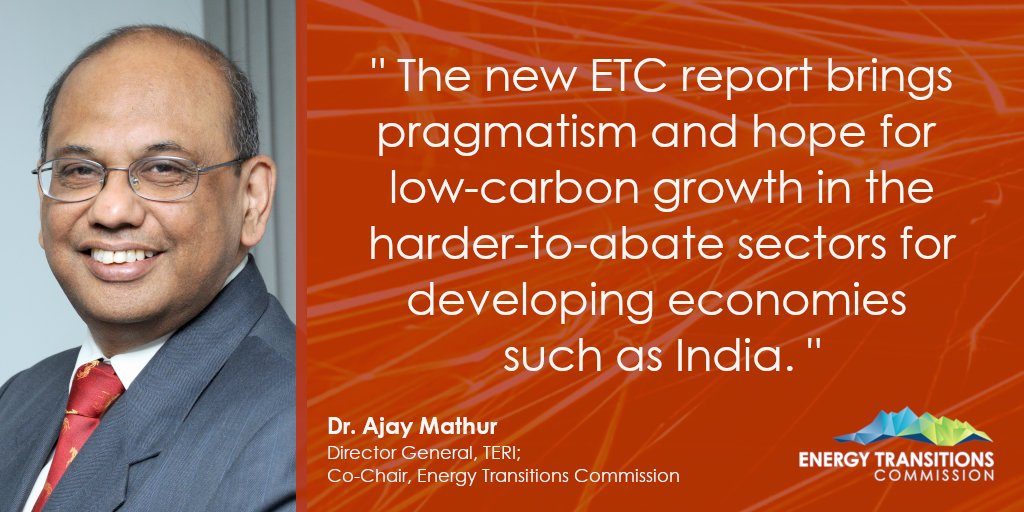The possibility of achieving
The big question is – can India too dream of achieving this ambitious goal or will it be more difficult than it is for the developed countries? The short answer is – India can achieve it faster with lesser transition pain than anyone else in the world because of its current low manufacturing and consumption base. That’s only if
To Lord Adair Turner India will need new manufacturing facilities like steel, cement

Lord Turner Chairs the Energy Transitions Commission. He also chairs the Institute for New Economic Thinking. He previously chaired the UK Financial Services Authority and UK Climate Committee. He also worked at McKinsey & Company. Ajay Mathur, head of TERI, is currently the co-chair of the commission. Both are currently working with the Indian government to draw up a zero carbon economy plan.
Excerpts of Lord Turner’s chat with Benedict Paramanand, Editor of SustainabilityNext on the sidelines of the India Sustainability Leadership Summit 2019 hosted jointly by Frost & Sullivan and TERI in Mumbai recently:
What are India’s Challenges with Climate Change
Challenges in India are not as much as it is in Europe because you don’t have such a high installed base. For example, India, unlike Europe, needs more steel plants. It’s easier to build new facilities on zero carbon.
It’s even more important for India to keep cost low especially in the electricity sector because of the affordability factor. We are very confident that India could get to 2400 terawatts hours of electricity compared to 1100 terawatts hours of electricity today by 2030 and of that 45% of generation could be zero carbon. We are very confident that it can be done at no extra cost to Indian consumer.
How can anyone influence policy in India
India is the most vulnerable country to climate change. If the temperature warms by 3 percent it would have terrible consequences. Looking at the terrible heat waves these days, India cannot but take tough calls. It can no longer sit back and blame the world. It has to fight its own battle. Institutions like TERI have a key role in influencing policy.
If you can get Indian youth to start saying that they would not join companies that are not strongly committed to climate change, it could make a difference, like it’s happening in the United States.
In Europe and the US, one of the things that pushed companies to change was because their young employees wanted them to.
What are Energy Transition Commission’s Achievements?
We are on a mission to convince the world that it is possible to achieve zero carbon standards in hard-to-abate sectors like steel, chemicals, heavy industries and Energy Transition Commission (ETC) was set up in 2017 with the belief that economic growth and climate action can be achieved together. ETC was convened to help identify pathways for change in global energy systems to ensure both better growth and a better climate.
ETC members include incumbent energy companies, industry disruptors, investors, equipment suppliers, non-profit organizations, advisors, and academics. “What they share is a progressive attitude to reforming the energy system,” states an ETC note.
ETC is funded by Energy Systems Catapult, the European Climate Foundation, the Grantham Foundation, OPower, the Rocky Mountain Institute, Royal Dutch Shell, Schneider Electric, Statnett
The challenge of decarbonization is decarbonisation of electricity. thing we have achieved a lot in the three years of our existence. Our Mission Possible report is extensively referred to in debates across the world. I think what we have done is
What’s your long-term game plan of ETC
We will go with this as long as it takes. We will take another 18 months to develop a vision for India. We are at an early stage in China. We hope we had some influence on China’s 14th Five Year Plan.
In the hard to abate
Role of Climate Communication
In Europe engagement of the green movement with schools has led to recent strikes. Youth is emerging as a very strong force pushing government towards making tighter commitments. “Green, Reliable and Viable: India’s Shift Towards Low-Carbon Energy”
The Energy and Resources Institute (TERI) released a book, “Green, Reliable and Viable: India’s Shift Towards Low-Carbon Energy” on Energy Transitions in India early 2019. It brings together perspectives from key stakeholders from the power, mobility, agriculture
It’s about solutions and next steps to move India forward on the
It suggests that seizing the opportunities can be achieved through a combination of integrated and timely policy frameworks, structural adjustments, and business strategies that can make transitioning to low-carbon energy both socially and economically desirable and feasible. Unleashing the full potential of the transitions will require all stakeholders to work together.














